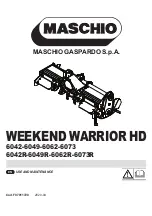
When a rear mounted implement is raised to the
transport position, the weight on the front wheels should
be at least 20% of total tractor weight.
Add additional front end ballast, as required, for stability
during operation and transport. Ballasting of the front
end may not always provide adequate stability if the
tractor is operated at high speed on rough terrain.
Reduce tractor speed and exercise caution under these
conditions.
When using front mounted implements, add weight to
the rear wheels to maintain traction and stability.
IMPORTANT :
Only sufficient weight should be added
as is necessary to provide traction and stability. Adding
more weight than necessary results in unnecessary
loads being imposed on the tractors and a higher fuel
consumption. When adding weight, adhere to the
maximum tire capacity loading stated in the tables
towards the end of Section C of this manual. If further
information or assistance is required on tractor weighing
consult your Dealer.
When adding ballast, the total weight of the tractor
including liquid, cast iron weights and mounted
equipment (where specified) should not exceed the
maximum shown in the following text entitled ‘Weighing
Limitations.
WARNING :
If proper stability cannot be
achieved within the following weighing limitations,
reduce the load on the tractor until stability is restored.
Weighing Limitations
For optimum driveline reliability and tractive efficiency,
maximum ballasted tractor weight (base tractor plus
ballast and any mounted equipment such as sprayers,
loaders etc., including the load carried there on) must
not exceed 6900 lb. (3130 kg.).
Maximum permissible rear axle loading with ballast and
mounted equipment is 6000 lb. (2722 kg.)
NOTE :
Total rear axle weight is measured with only
the rear wheels on the scales inclusive liquid and cast
iron ballast and with mounted equipment in the raised
position.
The total front axle load must not exceed 3000 lb. (1360
kg.) or the load capacity of the tires. See tire pressure
and Load Tables in Section C of this Manual.
NOTE : The front axle loading includes a front end loader
in the raised position with full load in the bucket.
The above mentioned maximum permissible load limits
are specified for speeds up to 10 mph (16 kmph.). For
speeds above 10 mph (16 kmph), the permissible
loading should be reduced by 20% from the limits
specified above.
Cast Iron weights
Up to three cast iron weights may be added to each
rear wheel. See Figure 34. The weights weigh 70 lb. (32
kg.) each, giving a maximum rear axle ballast weight of
420 lb. (194 kg.)
34. Rear Wheel Weights
Segmented, cast iron front wheel weights are available
as a set of four to give a total front wheel ballast weight
of 172 lb. (78 kg.). See Figure 35.
35. Front Wheel Weights
Wafer type front end weights are also available in sets
of five. The weights are mounted on a cast iron carrier.
The weights hook over the mounting bracket and are
secured by retaining bolts, Figure 36. Each wafer weight
weighs 60 lb (27 kg) to give a total weight per set of 330
lb (150 kg) including mounting bracket and installation
hardware.
SECTION A
21
















































